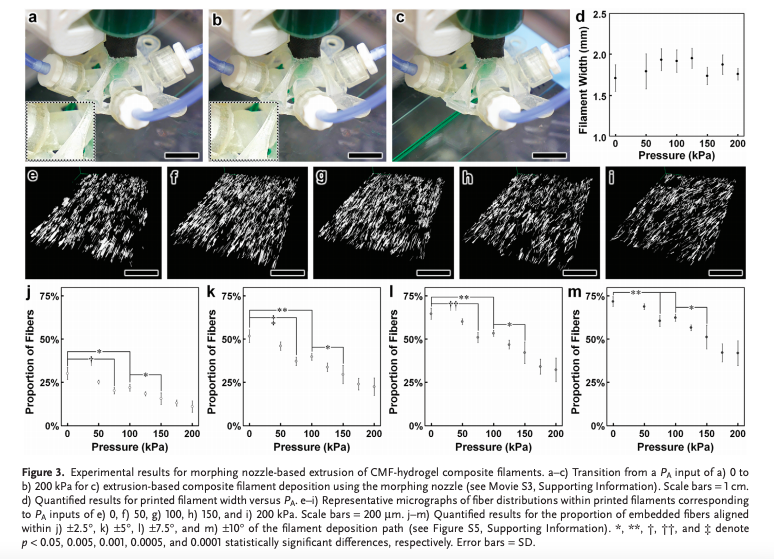Researchers at the University of Maryland (UMD) have developed a shape-changing 3D printer nozzle meant to tackle a particular method for 3D printing fiber composites. The nozzle is able to morph in such a way that it can change the orientation of short fibers in such materials as carbon fiber in order to improve such characteristics as strength or electrical conductivity.
In a paper published in Advanced Materials Technologies, the team discusses how actuators change the shape of the nozzle. Ryan Sochol, an assistant professor in mechanical engineering and director of the Bioinspired Advanced Manufacturing (BAM) Laboratory at UMD’s A. James Clark School of Engineering, said: “When 3D printing with the morphing nozzle, the power lies on their side actuators, which can be inflated like a balloon to change the shape of the nozzle, and in turn, the orientations of the fibers.”
The nozzle is made up of flexible bladders that are inflated pneumatically, which then changes the shape of the 3D printer nozzle from a straight channel to converging-diverging geometry, which then alters the orientation of fibers within the printing medium.
In particular, the team is applying its new technology to 4D printing materials that can switch from anisotropic to isotropic characteristics. UMD mechanical engineering professor David Bigio, a co-author of the study, explained: “In our work, we looked at how printed parts swelled when submerged in water, and specifically, if we could alter that swelling behavior using our morphing nozzle.”
Upon submerging the parts in water, it’s possible to cause swelling in one direction (anisotropic) or in all directions (isotropic), characteristics that can be designed into the parts and printing process. Thanks to the shape-shifting nozzle, it’s not necessary to use multiple materials. Connor Armstrong, lead author of the study, said, “What was exciting was discovering that we could cause a single printed material to transition between anisotropic and isotropic swelling just by changing the nozzle’s shape during the 3D printing process.”
“Importantly, the nozzle’s ability to morph and to even up the score in terms of swelling properties is not limited to 4D printing,” Noah Todd, study co-author and recently graduated mechanical engineering undergraduate student, contributed, “Our approach could be applied for 3D printing many other composite materials to customize their elastic, thermal, magnetic or electrical properties for example.”
The team tested the nozzle with carbon microfiber-hydrogels, changing the nozzle actuation pressure from 0 to 100 kPa and, in turn, reducing the number of aligned fibers. This caused a shift from anisotropic to isotropic water-induced swelling.
While the nozzle is for extrusion 3D printing, Stratasys PolyJet was used to print the nozzle itself, with flexible materials for inflatable side actuators and the morphing central channel and then rigid materials for the outer casing and access ports. Study co-author and mechanical engineering PhD candidate Abdullah Alsharhan said, “The use of multi-material PolyJet 3D printing enabled us to design the nozzle with an operating power range or set of pressure magnitudes that can be reproduced in essentially any research laboratory.”
Among the applications for which the group is considering using this technology is the 3D printing of biomedical objects that change shape in response to specific stimuli from the body, as well as producing weapons for the military.
“By providing researchers with an accessible way to 3D print fiber-filled composite materials with on-demand control of their fiber orientations, and thus, their ultimate performance,” Sochol said, “this work opens the door for new applications of 3D printing that harness these unique material properties and the distinctive capabilities they enable.”
What the UMD team has developed is an interesting addition to the growing array of fiber composite 3D printing technologies. Perhaps the most analogous process to what UMD has made is that of Fortify, a startup that uses digital light processing to 3D print composites. What makes Fortify’s process unique is the ability to orient the short fibers within its resins using magnets. Otherwise, most of the other companies in 3D printing fiber composites (Markforged, Desktop Metal, Anisoprint, Continuous Composites, Arevo, 9T Labs, etc.) are focused on 3D printing continuous strands of reinforcement fibers. Moreover, none of these firms have focused on 4D printing that we are aware of.
Subscribe to Our Email Newsletter
Stay up-to-date on all the latest news from the 3D printing industry and receive information and offers from third party vendors.
You May Also Like
3D Printing News Briefs, April 13, 2024: Robotics, Orthotics, & Hypersonics
In 3D Printing News Briefs today, we’re focusing first on robotics, as Carnegie Mellon University’s new Robotics Innovation Center will house several community outreach programs, and Ugogo3D is now working...
Rail Giant Alstom Saves $15M with 3D Printing Automation Software 3D Spark
3D Spark has entered into a three-year deal with the rail giant Alstom. Alstom, a transport behemoth with annual revenues of $16 billion, specializes in the manufacture of trains, trams,...
Meltio Expands Global Reach with New Partnerships in the Americas and Europe
Spanish 3D printing manufacturer Meltio has expanded its sales network across the globe. With the addition of three new partners in the United States, Brazil, Argentina, and Italy, Meltio aims...
3D Printing Webinar and Event Roundup: April 7, 2024
Webinars and events in the 3D printing industry are picking back up this week! Sea-Air-Space is coming to Maryland, and SAE International is sponsoring a 3D Systems webinar about 3D...

































